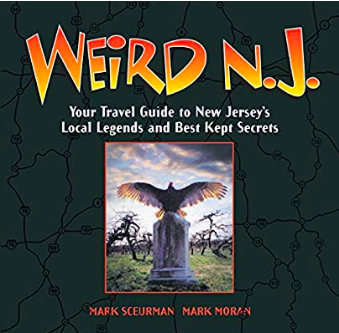Weird NJ: Why Tall Tales and Mysteries Matter (Editorial)

Cover image of the magazine “Weird NJ”
October 23, 2019
Stumbling Across the Strange
Ever since childhood, I’ve always been an advocate for the strange and bizarre. The combination of a highly-active imagination, a curious mind, and several interests cultivated within me an interest in stuff that either can’t be explained or just hasn’t been yet. Partly as a result, Halloween became my favorite holiday. The aesthetic of masks, ghost stories, and the unknown appealed to some deep aspect of my soul. Of course, treat-o’-treating and fun costumes also played a role, but the spooky mystery of Halloween made it distinct to me; after all, you can eat candy year-round.
This October, I sought to pay tribute to the holiday via several of my projects and articles. Halloween seemed perfect since it provides a topical yet interesting topic of discussion. That brings me to this article. Originally, I planned to write about a lesser-known urban legend unique to New Jersey; I was tired of hearing about the Jersey Devil every year since 4th grade, so I wanted something new. However, as I flipped through a few of my books and rapidly Googled, the sheer volume of choices began to overwhelm me. New Jersey has so much folklore and so many places that I could have written an article on a new one every week and taken decades to run out of publicly-known stories. However, all of that stress got me thinking of the bigger picture.
Weird NJ
Many of you have probably read articles from the Weird NJ magazine, read one of their books, or spent time on their website. Combined, Weird NJ is often touted as one of the best resources for a New Jersey resident looking to entertain their curiosity or plan a day trip. However, Weird NJ began (and remains) humble. Mark Sceurman and Mark Moran started it as a tiny newsletter in 1989, but word of mouth caused a steady spread until it became a more proper magazine. The two Marks still run most of the operation. Readers will contact the Marks via any of several methods and give them locations of stories一or a vague impression of one. When asked about how they find their bizarre stories, the Marks responded saying, “And while many readers send us stories that we publish, more often they tell us something like, “Hey, have you guys seen this place? It’s really weird, and you should go check it out!” So, armed with little more than our Hagstrom maps and the question, ‘What’s weird around here?’ we set out one day a week in search of New Jersey’s local legends and best-kept secrets” (Sceurman and Moran 6).
Cool, But Why Does That Matter?
Weird NJ and countless other similar operations catalog and distribute oddities all across the country. More than an interesting read or a source of adventure, folklore, and urban legends provide incredibly vital (and often unintentional) services to the community and to the individual.
First, having a culture rich with stories, be they real or not, can provide an incredible outlet for imagination and creativity. I suspect that if you think back hard enough to your childhood, you can remember speculating with neighbors about a house you thought was haunted or something you saw in the forest. While that might sound too much like To Kill a Mockingbird, almost everybody has either told or been told a ghost story. Don’t forget, of course, the more real pieces of local lore; many children’s interests in history have originated from learning the history of their town. In a culture that discourages expression or a family that shuts down the imagination of their children, this critical developmental avenue is shut down. Furthermore, these bits of either legend or fact can have plenty of personal positive effect. As the Marks put it, “There is a certain pride that our readers share in telling us about something strange that lurks in their neighborhood” (Sceurman and Moran 6). I believe that to grow as people, kids (and adults!) sometimes need to let go of what they know and embrace the eccentric.
Local strangeness and folklore can also define a community and bring them closer together. The truth is, not everybody in a community will believe in any given weird spot. Whether it’s a ghost story or confirmed history, there will always be skeptics (for some tales more than others). However, members of a community that don’t believe in something can still rally around it. Take the core idea of Halloween, for instance. Many people don’t believe in ghosts, believe that the dead move straight on, or just don’t believe in an afterlife. Despite that, everybody can rally around the mutually-agreed festival of Halloween. The more you think about it, the stranger it gets. Not only are little children allowed to literally take candy from strangers’ houses, they are encouraged to by their parents! That might be a macro-level example, but thousands of settlements around the world have unique festivals, celebrations, or traditions centered around their own chunk of weirdness. As Weird NJ eloquently puts it, “Whether it’s an abandoned village for epileptics or just a greasy hot dog stand alongside Route 1, it’s all part of the unique culture of this state that we are proud to call home.”
Works Cited
Moran, Mark, and Mark Sceurman. “About Weird NJ.” Weird NJ, Weird NJ, weirdnj.com/about-weird-nj/.
Sceurman, Mark, and Mark Moran. Weird N.J.: Your Travel Guide to New Jersey’s Local Legends and Best Kept Secrets. Sterling Pub. Co., 2009.
Sceurman, Mark, and Mark Moran. “Weird N.J.: Your Travel Guide to New Jersey’s Local Legends and Best Kept Secrets.” Amazon, Sterling Pub. Co., 2009, www.amazon.com/Weird-N-J-Jerseys-Legends-Secrets/dp/1402766858.
